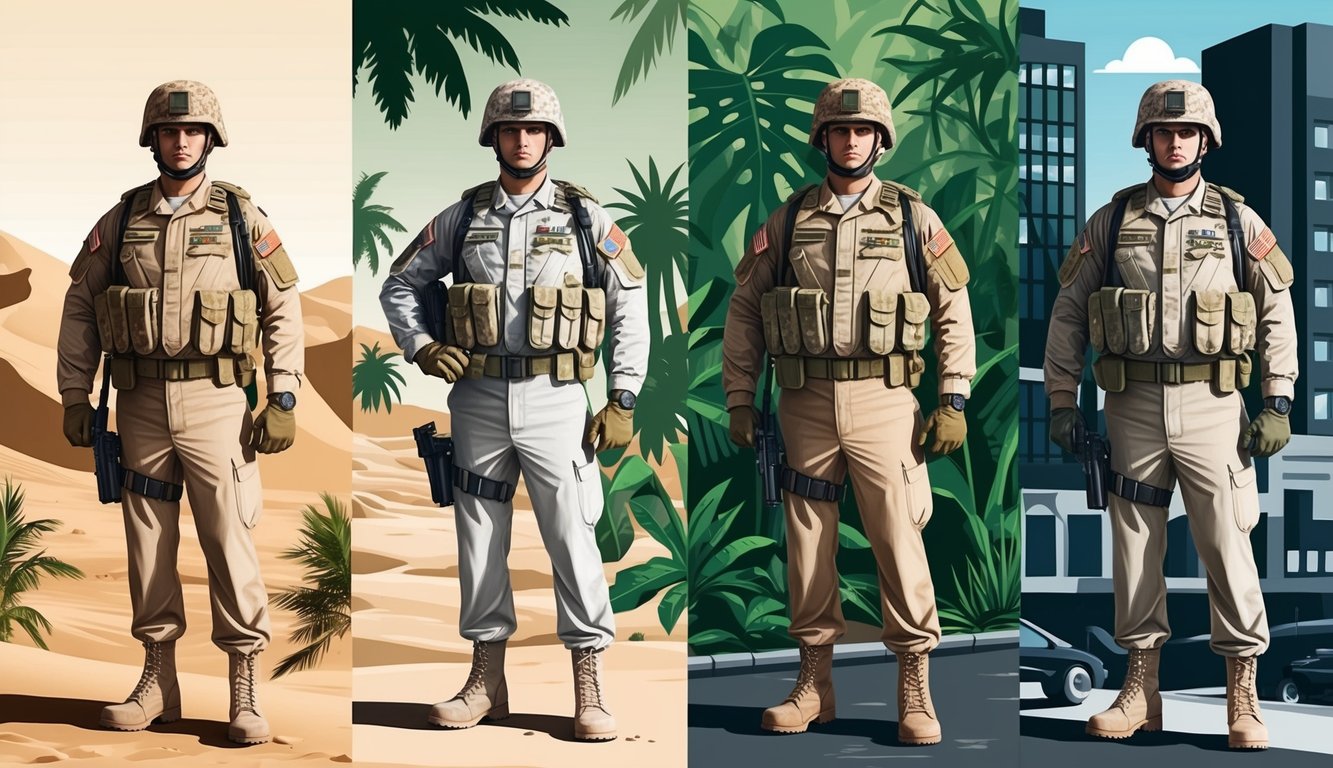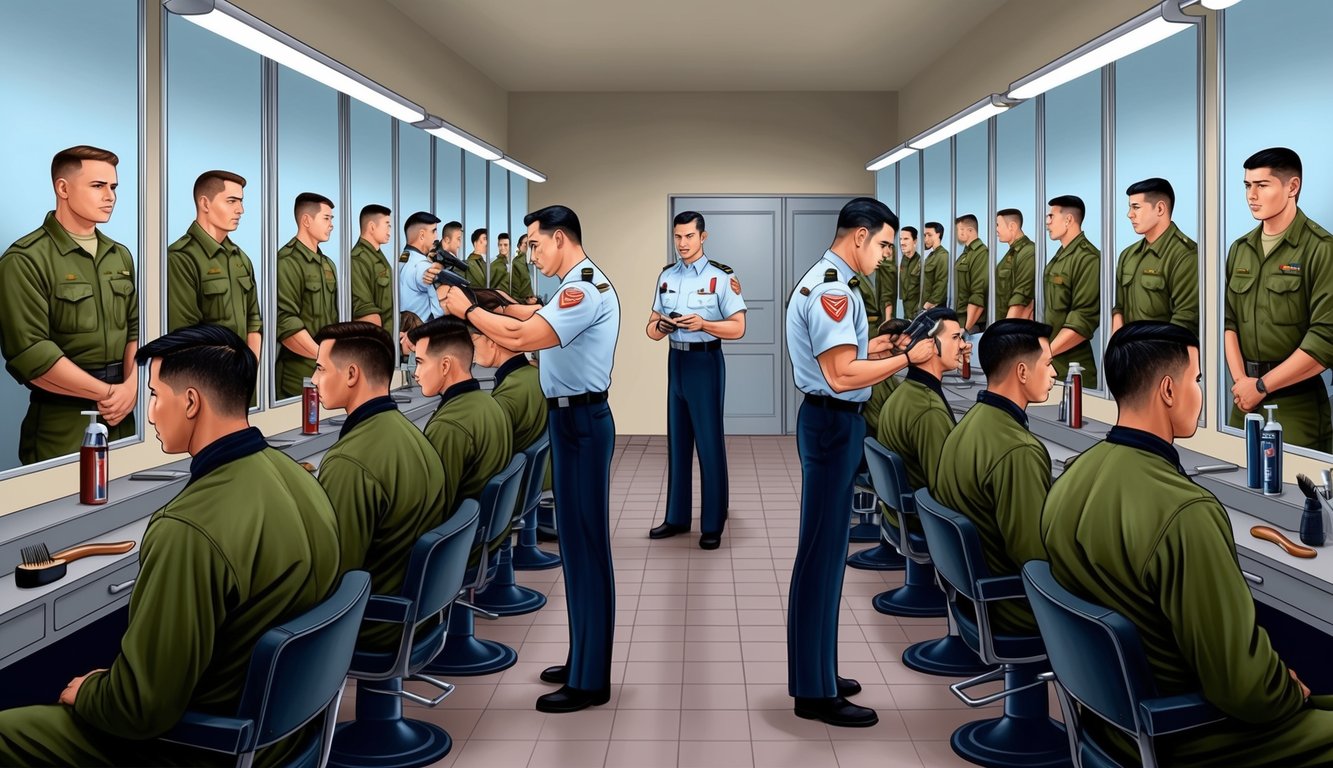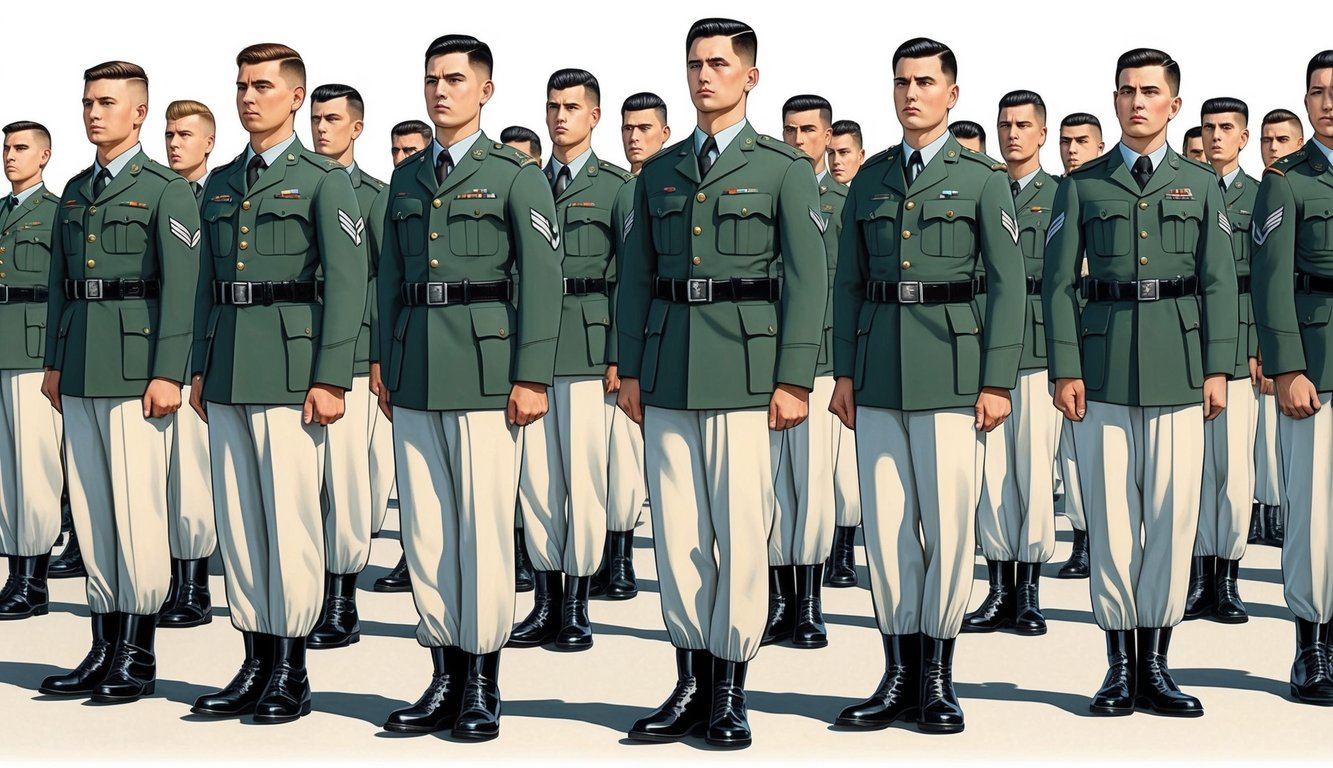“`xml
The grooming standards of the Army are essential for ensuring discipline, professionalism, and uniformity within the U.S. military.
These standards encompass various aspects, from hairstyles to facial hair, ensuring that soldiers maintain a clean and polished look while on duty.
Recently, the Army has revised its grooming policies to enhance inclusivity and diversity among its members. The updates include the acceptance of natural hair colors, the elimination of minimum hair length requirements, and the allowance of ponytails in all uniforms except during tactical operations or physical training.
These modifications are designed to support soldiers’ well-being while upholding the high standards expected of military personnel.
As a member of the Army, it is important to understand the specific guidelines based on your gender, which include rules regarding hair, facial hair, and accessories such as earrings.
By following these standards, you help maintain the professionalism and cohesion of the U.S. Army.
Key Takeaways
- The Army grooming standards ensure a consistent and professional look for all soldiers.
- Recent changes aim to foster inclusivity while upholding high presentation standards.
- Guidelines vary by gender and situation, covering hair, facial hair, and accessories.
History and Purpose of Army Grooming Standards
Army grooming standards have evolved throughout the years, reflecting changing societal norms while preserving the core principles of discipline and professionalism.
These regulations encourage uniformity and reinforce military values.
Evolution of Appearance Standards
In the early history of the U.S. Army, grooming standards were not as formalized.
As the military expanded, more specific rules were introduced.
During World War II, short hairstyles became the standard for practical reasons.
In response to civilian trends during the 1960s and 70s, regulations tightened, resulting in the ban of long hair and beards, though exceptions were made for medical or religious reasons.
In recent years, some of these standards have been relaxed.
For instance, in 2021, the Army announced changes to offer more flexibility for women’s hairstyles and for men’s facial hair.
Commitment to Discipline and Professionalism
The grooming standards promote the Army’s values of discipline and professionalism.
By following these regulations, soldiers demonstrate their attention to detail and compliance with orders.
A tidy, uniform appearance contributes to unit cohesion and pride while enhancing the Army’s public image, ensuring a professional representation.
The goal is to balance individual expression with military necessities.
While some rules may seem stringent, they are crucial for maintaining readiness and unit effectiveness.
Regulations Overview
Army grooming standards are detailed regulations that outline acceptable appearance for soldiers.
These rules address everything from hairstyles to uniform presentation to ensure a professional military image.
Understanding AR 670-1
AR 670-1, or Army Regulation 670-1, serves as the primary document detailing the grooming and appearance standards for U.S. Army personnel.
It includes regulations on hair length and styles, facial hair, makeup, and jewelry.
For men, hair must be neat and conservative, staying above the ears and collar.
Women’s hair should not fall below the collar’s bottom edge while in uniform.
This regulation also covers fingernail length, tattoos, and body piercings.
While tattoos are allowed, they cannot be on the face, neck, or hands, with exceptions for a single ring tattoo on a finger.
Women in uniform may wear small, conservative earrings.
Wear and Appearance of Army Uniforms and Insignia
This section of AR 670-1 provides comprehensive guidelines on correctly wearing Army uniforms.
It outlines proper placement and use of patches, badges, and insignia.
Detailed rules cover everything from the correct wearing of a beret to acceptable socks.
The regulation specifies which uniforms to wear on varied occasions and how to maintain them.
It also provides guidelines for wearing civilian attire while on duty.
Your uniform appearance reflects on the entire Army, making attention to detail critical.
Specific Standards for Male Soldiers
The U.S. Army has specific grooming standards for male soldiers to uphold a professional and uniform appearance.
These regulations address various grooming aspects, including hair length and tattoos.
Hair and Hairstyles
Your hair should be neat, clean, and well-groomed.
It must be tapered and not exceed 3 inches from the scalp.
Avoid trendy styles such as mohawks or long hair slicked back.
Ensure your hair does not touch your ears, eyebrows, or collar when combed.
Sideburns may not extend below the bottom of your ear opening.
Dyeing hair is permitted, provided it is a natural color; extreme colors like blue, purple, or neon shades are not allowed.
If you have textured hair, braids or twists are acceptable as long as they are uniform in size.
Remember that your hairstyle should not obstruct the proper use of headgear or protective equipment and must not interfere with your ability to perform your duties safely.
Facial Hair and Mustache Regulations
Generally, soldiers are required to maintain a clean-shaven face.
Mustaches are permitted but must be neatly trimmed.
Your mustache should not extend beyond the corners of your mouth or below your upper lip line.
Handlebar or bushy styles are not permitted.
Beards are typically not permitted unless for medical or religious reasons.
Soldiers with shaving profiles due to skin conditions must keep their facial hair trimmed to 1/4 inch or less.
For religious accommodations, a request must be submitted through your chain of command.
If approved, you must maintain a neat and groomed beard.
Tattoo and Piercing Policy
Tattoos are allowed with certain restrictions.
They cannot be located on the face, neck, or hands (except for a single ring tattoo on a finger).
Other tattoos are generally permissible as long as they are not offensive or extremist.
Body piercings are not allowed while in uniform or on duty.
Small, conservative earrings can be worn off duty in civilian clothing, but ear gauges or body modifications such as tongue splitting are prohibited.
Be mindful that excessive tattoos or piercings could impact promotion potential or specific job assignments.
Headgear and Uniform Considerations
Wear your headgear squarely on your head.
If wearing a beret, it should be shaped to the right side.
Ensure your patrol cap is correctly positioned on your head, without any hair visible on your forehead.
Your uniform should be clean, pressed, and fit properly.
Buttons must be fastened, with sleeves rolled down.
Boots should be securely laced and tied.
While in your dress uniform, pay extra attention to detail.
Your ribbons and badges should be properly placed and aligned.
Always wear your cover (hat) outdoors and remove it indoors, except during formal ceremonies.
Specific Standards for Female Soldiers
The grooming standards for female soldiers are designed to allow personal expression while maintaining a professional military appearance.
These guidelines encompass hairstyles, accessories, and cosmetics to ensure uniformity and readiness.
Hair Styling and Length
You may style your hair in various ways as long as they are neat and do not interfere with your headgear.
Hair should not fall below the bottom edge of your collar while in uniform.
Bangs are allowed but must not fall below your eyebrows.
For longer hair, options include buns, ponytails, or braids.
Ponytails are now allowed during physical training and can extend up to 7 inches in length.
Buns must be secured and not exceed 3.5 inches in diameter.
Natural hairstyles such as locs and twists are permitted, provided they are well-maintained and adhere to the same length guidelines as other hairstyles.
Authorized and Prohibited Hairstyles
You can select from various authorized hairstyles that comply with regulations, including:
- Single braids
- French braids
- Dutch braids
- Cornrows
These styles should maintain uniformity and follow a straight line to the back of your head.
Prohibited hairstyles consist of:
- Mohawks
- Trendy styles
- Shaved designs on the scalp
Your hair color should blend uniformly and appear natural, with extreme colors like blue, purple, or neon shades not permitted.
Jewelry and Accessories
You are allowed to wear conservative jewelry that does not interfere with your duties.
Earrings are permitted in specific situations:
- Small, spherical earrings in gold, silver, white pearl, or diamond
- One earring per earlobe while in uniform
- Up to three earrings per earlobe in civilian clothing
Necklaces should remain hidden inside your uniform.
Wedding rings and wristwatches are allowed.
Hair accessories, such as bobby pins, small barrettes, and elastic bands, should match your hair color or be black, brown, or clear.
Cosmetic Usage
Makeup that enhances your natural features and skin tone is permitted, as long as it remains conservative and suitable for a military setting.
Guidelines include:
- Lipstick: Choose shades that harmonize with your skin tone and uniform.
- Eyeshadow: Opt for neutral colors that blend well.
- Mascara and eyeliner: Apply subtly to enhance your natural look.
Bright or bold colors are not allowed.
False eyelashes should look natural and not be excessively long.
Nail polish in subdued shades is acceptable, with clear or natural-looking polish always permitted.
Avoid bright colors, patterns, or designs.
Grooming for Inclusivity and Diversity
The U.S. Army recently updated its grooming standards to better reflect and support the diversity of its members.
These changes strive to establish a more inclusive atmosphere for all soldiers while retaining professionalism.
Updates for Cultural and Gender Diversity
Noticeable changes in hair regulations have been made for both genders.
Female soldiers can now wear ponytails and braids in any uniform.
These updates address concerns about hair damage and scalp health.
Men can maintain neatly trimmed facial hair for medical or religious reasons.
The Army now allows small tattoos on hands, behind the ears, and on the back of the neck.
Such changes acknowledge diverse cultural practices and personal expressions while ensuring a professional military appearance.
Breastfeeding and Pumping Provisions
New mothers in the Army now receive increased support.
You are allowed to breastfeed or pump in any location where you are otherwise authorized to be.
The Army provides designated lactation rooms in numerous facilities.
These areas offer privacy and essential amenities for nursing or pumping.
Commanders must ensure that adequate time and space are available for these activities.
This policy aims to simultaneously support soldier readiness and family well-being.
Project Inclusion Initiatives
Project Inclusion is an Army-wide initiative aimed at fostering diversity and equity.
As part of this effort, the Army has removed official photographs from promotion board packages to minimize potential biases in the decision-making process.
Additionally, the Army is reviewing hairstyle regulations to ensure they do not unfairly affect soldiers of different ethnic backgrounds.
Ongoing efforts will continue to create mentorship programs and leadership opportunities for underrepresented groups.
These initiatives aim to develop a more inclusive culture throughout the Army, from recruitment to retention and promotion.
Grooming Standards Across Different Environments

Army grooming standards adapt to various environments and types of uniforms.
Different rules apply based on your operational conditions and the uniform you’re wearing.
Operational and Tactical Considerations
In tactical situations, prioritize safety and effectiveness in grooming.
When wearing the Operational Camouflage Pattern or Improved Hot Weather Combat Uniform, ensure your hair is neat and properly secured to avoid interfering with combat helmets or tactical gear.
Facial hair is generally restricted in combat zones to ensure proper sealing of gas masks, making beards often prohibited.
However, mustaches that do not extend beyond the corners of the mouth are typically acceptable.
For camouflage purposes, avoid using brightly colored hair products.
Stick to natural hair colors that blend with your surroundings.
Combat Uniforms Versus Service Uniforms
Grooming standards will differ when wearing combat uniforms compared to service uniforms, such as the Army Green Service Uniform (AGSU).
In combat uniforms, practicality is crucial; hair should be short enough not to touch the ears or collar.
More flexibility is allowed with service uniforms.
Women can wear their hair in a bun, braid, or ponytail, while men’s hair should be neatly trimmed and styled.
Nail polish and makeup rules are stricter in combat conditions.
In service uniforms, women can wear conservative nail polish and makeup, while men’s grooming for service uniforms allows for a more polished appearance compared to field conditions.
Guidance and Enforcement

The Army’s grooming standards require consistent implementation and oversight.
Leaders play a vital role in upholding these regulations, and consequences exist for those who do not comply with established criteria.
Role of Leadership and Senior Leaders
Senior leaders like Lt. Gen. Gary Brito and Sgt. Maj.
Mark Anthony Clark are crucial in establishing the standards for grooming.
They stress the significance of adhering to these regulations to maintain discipline and professionalism.
Leaders at all levels are tasked with the daily enforcement of grooming standards.
They conduct inspections while providing guidance to ensure compliance.
It is often reiterated that proper appearance maintains unit cohesion and readiness.
Senior leaders also update policies when required, considering soldier feedback and adapting standards to promote diversity and inclusion while maintaining a professional image.
Consequences of Not Adhering to Standards
Failure to meet grooming standards can result in various consequences.
This may range from verbal counseling to harsher disciplinary actions.
Leadership might require immediate correction of issues, such as getting a haircut or shaving.
Repeated violations could lead to:
- Negative counseling statements
- Loss of privileges
- Extra duty assignments
- Adverse effects on performance evaluations
In severe cases, continuous non-compliance could result in administrative actions or even separation from service.
Remember, grooming standards are part of the Army’s “People First” priority, emphasizing personal accountability and unit readiness.
Additional Considerations for Army Personnel

Army grooming standards extend beyond active duty members, incorporating nuanced requirements for National Guard and Reserve personnel, considerations when transitioning between civilian and military life, and potential health implications.
National Guard and Reserve Grooming Standards
You may wonder whether National Guard and Reserve personnel follow the same grooming rules as active duty soldiers.
The answer is yes, but with some leniency.
When in uniform or engaged in official duties, you must adhere to the same standards as active duty soldiers, covering hair length, facial hair constraints, and uniform appearance.
However, during non-drill periods, you have more flexibility.
You can grow your hair longer or maintain facial hair, as long as you are prepared to meet regulations when called to duty.
Plan ahead when approaching drill weekends or annual training periods by adjusting your appearance accordingly.
Transitioning Between Civilian and Military Life
Switching between civilian and military grooming standards can be challenging.
Adaptability and planning are key.
If you are entering basic training or officer training, expect a significant change in your grooming routine.
You may be required to cut your hair short and remove any facial hair before you arrive.
For those in Army roles requiring frequent transitions, consider maintaining a style that is easily adaptable to military standards.
This might mean keeping your hair slightly longer than regulation but manageable for trimming.
Women may want to practice military-approved hairstyles that can function well in both civilian and military environments.
Neat buns or braids can serve both purposes effectively.
Health and Wellness Implications
Grooming standards are not solely about appearance; they can also influence your health and wellness.
Regular shaving may cause skin irritation or ingrown hairs.
To minimize these issues:
- Use sharp, clean razors.
- Shave in the direction of hair growth.
- Apply a soothing aftershave.
Tight hairstyles required for long hair might lead to tension headaches or even hair loss.
Whenever possible, vary your hairstyle and provide your scalp with breaks during off-duty periods.
Take care of your feet as well.
Trim toenails to prevent ingrown nails and blisters during prolonged marches or runs.
Frequently Asked Questions

The Army routinely updates its grooming standards to reflect societal changes while maintaining a professional military image.
Recent updates have expanded options for both male and female soldiers.
What are the latest updates to haircut regulations in the Army?
Male soldiers can now have longer hair on top, as long as it remains neat and professional.
Fades and undercuts are permitted, while female soldiers can wear ponytails in all uniforms.
How have female hair grooming standards in the Army changed recently?
Female soldiers are now allowed to wear ponytails or braids in all uniforms, including during physical training.
Hair can touch the collar in certain styles.
Highlights and hair accessories that match natural hair colors are also permitted.
What are the specific AR 670-1 guidelines for male haircuts in the Army?
Male hair must be tapered, maintain neatness, and not make contact with the ears or collar.
The bulk of hair cannot exceed 2 inches, and sideburns must not extend below the bottom of the ear opening.
What are the acceptable hairstyles for women serving in the Army?
Approved styles include buns, braids, twists, cornrows, and ponytails.
Hair can be parted in any style, provided it allows for proper wear of headgear and does not interfere with protective equipment.
What are the restrictions on hair color and styling for Army personnel?
Hair color must look natural and complement skin tones; extreme colors such as purple or green are prohibited.
Trendy styles like mohawks and shaved designs are also not allowed.
How frequently are the Army grooming standards updated?
The Army reviews grooming standards periodically, typically every few years.
Significant updates occurred in 2021 while minor adjustments may happen more frequently, based on soldier feedback and evolving norms.
“`

